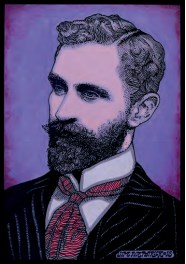Casement’s Black Diaries
Published in Issue 6 (November/December 2016), Letters, Volume 24 Sir,—A coda, if I may, to my article ‘Roger Casement and the History Question’ (HI 24.4, July/August 2016) that responds to the letters in the following issue. When working as a historical consultant for the exhibition at Kerry County Museum, ‘Casement in Kerry: A Revolutionary Journey’, I supported the idea of the curator, Helen O’Carroll, to apply for a loan of the Black Diaries from the National Archives (UK). In turning down her application, Juergen Vervoorst, Head of Conservation, reasoned that ‘we can only guarantee the files’ [diaries’] continued authenticity whilst they remain at the National Archives’. Such an unusual excuse, surely, reveals an internal anxiety about the status of the documents on the part of the very institution where they are deposited.
Sir,—A coda, if I may, to my article ‘Roger Casement and the History Question’ (HI 24.4, July/August 2016) that responds to the letters in the following issue. When working as a historical consultant for the exhibition at Kerry County Museum, ‘Casement in Kerry: A Revolutionary Journey’, I supported the idea of the curator, Helen O’Carroll, to apply for a loan of the Black Diaries from the National Archives (UK). In turning down her application, Juergen Vervoorst, Head of Conservation, reasoned that ‘we can only guarantee the files’ [diaries’] continued authenticity whilst they remain at the National Archives’. Such an unusual excuse, surely, reveals an internal anxiety about the status of the documents on the part of the very institution where they are deposited.
Political expediency inevitably overrules in the pursuit of historical ‘truth’ wherever Casement is concerned. The entanglements of the Black Diaries continue to mesmerise the public, confuse journalists, inspire playwrights, embarrass governments and silence historians. Securely archived beside the Royal Botanic Gardens at Kew, they endure as a rupturing aide-mémoire to the excesses of the age of high imperialism as it imploded into the mechanised slaughter of the Western Front and that flash of defiance in Dublin in 1916. The collective intellectual failure to bring about a satisfactory conclusion to the question of their authority reveals a crisis at the heart of Irish revisionism.
Reading between the respective national archives in London and Dublin, it is possible to trace how the innuendoes used in 1916 to execute Casement were transformed over the years by the Anglo-Irish entente cordiale. Through the fusion of a compliant media and careful diplomatic handling emerged ‘consensus’ and a ‘majority view among historians’. The Black Diaries were manufactured and promoted inside that undocumented alliance bridging national intelligence agencies and the Oxbridge axis. Apparently, the present line from within that nexus is: does it really matter if the diaries are forged or not? It doesn’t matter only if we don’t care about the truth. Mary Kenny’s letter demonstrates that we should care.—Yours etc.,
ANGUS MITCHELL
Limerick
Sir,—In response to the letters (HI 24.5, Sept./Oct. 2016) from Jeffrey Dudgeon and Mary Kenny on aspects of the Casement articles published in the previous issue, the following points might interest your readers. To be convincing, Jeffrey Dudgeon should explain why he prefers the version of one policeman to that of another and why other believers in authenticity disagree with his choice of policeman. Since at least one of the policemen was lying, he should explain how he knows which one was not lying. He should also explain why he believes any of the versions. Quinn’s Minute of 22 June claims that books and diaries were delivered by Germain, but the police list of contents shows no books in those two trunks. But even this misses the point; the existence of police documents attesting to the delivery/discovery of diaries proves nothing. There is no verifiable record that the diaries now in the UK National Archives were shown to anyone in this period. Typescript pages were widely shown but Casement did not type those pages.
Mary Kenny’s claim that Birkenhead showed the Black Diaries to George V is unsubstantiated in the extensive Casement literature of the past 60 years. It is recorded only that he saw typescript pages, like everyone else—the same typescript that Birkenhead offered to Casement’s defence. What has not been explained by the ‘authenticity authors’ is why typescripts were prepared for showing when it would have been easier, quicker, more convincing and more economical simply to show the diaries or photographic copies of these. This could have been done in days and would have made the later, unconvincing attempts at corroboration quite unnecessary. The above confusions are examined in depth in the research essays available at www.decoding-casement.com, which readers might wish to consult.—Yours etc.,
PAUL R. HYDE
















